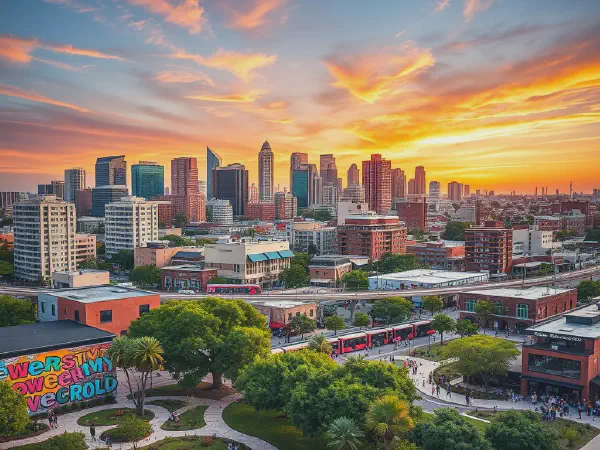Vision: Inside Filner’s Strategy for a More Inclusive San Diego

Vision: Inside Filner’s Strategy for a More Inclusive San Diego
Understanding Filner’s Vision for Inclusivity in San Diego
What is Filner’s vision for an inclusive San Diego?
Bob Filner, during his tenure as mayor, articulated a compelling vision for an inclusive San Diego, prioritizing social justice and the active participation of diverse communities in local governance. His strategy emphasized the need for community engagement to ensure that all voices were heard and represented in public policy decisions. Filner aimed to create an environment where policies not only addressed the needs of the majority but also uplifted marginalized groups, fostering a sense of belonging for every San Diegan.
Key principles of inclusivity in urban planning
At the heart of Filner's approach to urban planning were several key principles aimed at promoting equity and diversity. One significant principle was the incorporation of community input in the planning processes. Filner encouraged public forums and workshops to allow residents to voice their concerns and suggestions regarding urban development projects. This participatory approach was essential in shaping inclusive policies that reflected the demographic diversity of San Diego, a city characterized by its rich tapestry of cultures and ethnicities.
Additionally, Filner emphasized the importance of accessible public spaces and services, advocating for the development of parks, transportation systems, and housing that catered to the needs of all residents, including low-income families and individuals with disabilities. By integrating these principles into urban planning, Filner sought to dismantle barriers that historically excluded certain groups from fully participating in the life of the city.
Historical context: San Diego before Filner's strategy
Prior to Filner's administration, San Diego faced significant challenges in terms of inclusivity and representation. Many community organizers noted that policies often favored affluent neighborhoods, leaving lower-income areas underserved. For instance, urban development initiatives frequently overlooked the needs of communities of color, resulting in a lack of adequate housing and public amenities.
As San Diego's demographics evolved, with a growing population of immigrants and underrepresented communities, the call for inclusive policies became more pronounced. Filner's strategy emerged as a response to these historical inequities, aiming to reshape the narrative of local governance by prioritizing the voices of those who had been systematically marginalized. His vision not only aimed to address past injustices but also to set a new standard for how cities can embrace diversity and foster a truly inclusive environment for all residents.
Major Strategies Implemented by the Filner Administration
Community engagement initiatives
Under the leadership of Mayor Bob Filner, the Filner administration placed a strong emphasis on community engagement as a cornerstone of its inclusive policies. One notable initiative was the establishment of the San Diego Community Advisory Board, which was created to ensure that voices from diverse neighborhoods were heard in local governance. This board included representatives from various ethnic and socioeconomic backgrounds, allowing for a more comprehensive representation of the city’s population.
Exploring the initiatives proposed in Inside Filner’s Strategy for a More Inclusive San Diego reveals a commitment to community engagement and diversity.
Furthermore, Filner’s administration organized regular town hall meetings across different districts, inviting residents to discuss pressing issues such as urban planning and public safety. These gatherings not only fostered dialogue between citizens and officials but also empowered residents to contribute to the decision-making process, thereby enhancing equity in public policy.
Collaborations with local organizations
Collaboration was key to the Filner administration’s approach to achieving social justice and community inclusivity. The administration partnered with local organizations such as the San Diego LGBT Community Center and the Alliance San Diego to address the unique needs of marginalized groups. These partnerships helped to create targeted programs aimed at increasing access to city resources and services.
For instance, the administration worked with these organizations to launch the San Diego Immigrant Rights Project, which provided legal assistance and resources for undocumented residents. By aligning with established community organizations, Filner not only gained the trust of residents but also ensured that initiatives were culturally competent and effectively met the diverse needs of the city’s population.
Policy changes and their impact
The impact of the policy changes initiated by the Filner administration can be seen across various sectors, particularly in urban planning and public policy. One significant change was the introduction of the Equity in Development Policy, which mandated that all new development projects include affordable housing units. This policy aimed to address the growing disparity in housing access and promote diversity within neighborhoods.
Additionally, the administration launched the Citywide Equity Index, which assessed the social and economic disparities among different communities in San Diego. The data collected from this index informed future policy decisions, ensuring that inclusivity remained a priority in all aspects of governance. The Filner administration’s commitment to systematic change not only advanced the conversation around inclusive policies but also laid the groundwork for ongoing improvements in community engagement and support for underserved populations.
Impact of Filner’s Policies on Different Communities
Assessment of inclusivity across demographics
During Bob Filner's administration, his push for inclusive policies in San Diego aimed to address the needs of various demographic groups, including low-income families, minorities, and the LGBTQ+ community. For instance, the San Diego Housing Commission introduced programs that provided affordable housing options specifically for low-income residents, focusing on areas like City Heights and Logan Heights. These initiatives sought to enhance community engagement by involving residents in the urban planning process, ensuring that diverse voices were heard in local governance.
Success stories from local communities
One of the notable success stories from Filner's policies is the establishment of the Office of the Independent Budget Analyst, which has provided transparency and accountability in budgeting decisions. This office played a crucial role in promoting equity, as it allowed community organizers from diverse backgrounds to better understand how funds were allocated and to advocate for their neighborhoods. Additionally, the San Diego Pride Parade saw increased support from the Filner administration, which fostered a more inclusive environment for the LGBTQ+ community and highlighted the importance of social justice in public policy.
Challenges and areas for improvement
Despite these achievements, challenges remain in fully realizing Filner’s vision for an inclusive San Diego. Issues such as gentrification and displacement continue to affect low-income neighborhoods, highlighting the need for improved strategies in urban planning. Furthermore, community engagement efforts often fell short in reaching underrepresented groups, demonstrating a need for more effective outreach programs. As Filner's policies evolve, it is essential to ensure that inclusivity remains a priority, addressing both the successes and shortcomings to foster true diversity and equity across all communities in San Diego.
Feedback from Community Members and Stakeholders
Interviews with local residents
To gain a comprehensive understanding of the impact of Bob Filner's initiatives on San Diego, several interviews were conducted with local residents, revealing a spectrum of opinions on the administration's approach to inclusive policies. For instance, Maria Gonzalez, a resident of City Heights, expressed her appreciation for the Filner administration's efforts in urban planning, stating, "The new community gardens and public spaces are making a real difference in our neighborhood, encouraging diversity and community engagement." However, other residents like John Thompson from La Jolla voiced concerns about the pace of change, noting that "while the intent is commendable, some initiatives seem rushed and don’t fully address the needs of all communities." These testimonials highlight the complexities of implementing equitable policies in a diverse city like San Diego.
Reactions from community organizations
Community organizations have also weighed in on Filner's strategies. The San Diego LGBT Community Center, for example, lauded the administration for its commitment to social justice and equity, stating that "Filner's focus on inclusivity has opened doors for marginalized groups that have long been overlooked." Conversely, the San Diego Coalition for Housing Justice pointed out that while housing initiatives are progressive, they lack sufficient funding and support. Their spokesperson, Lisa Harper, stated, "Without proper investment in affordable housing, we risk further alienating low-income families, which contradicts the very essence of inclusivity." Such feedback underscores the necessity for ongoing dialogue between the administration and community stakeholders.
Balancing diverse voices
As the Filner administration moves forward, balancing the diverse voices of San Diego's residents remains crucial. Incorporating feedback from various sectors—such as business owners, environmental activists, and social justice advocates—can significantly enhance public policy. The challenge lies in ensuring that no voice is marginalized, particularly those from historically underrepresented communities. As stated by community organizer David Kim, "Inclusive policies are not just about representation; they are about creating a collaborative environment where every stakeholder feels heard and valued." This approach is essential for fostering trust and achieving meaningful change within San Diego's local governance.
Visions for the Future of Inclusivity in San Diego
Sustaining momentum beyond Filner
As the Filner administration transitions, it is crucial for San Diego to sustain the momentum built around inclusivity. The groundwork laid during his tenure has opened avenues for broader participation in local governance, particularly through initiatives such as the San Diego Equity Index. This tool assists city planners in assessing community needs, focusing on equitable resource distribution. To keep this momentum, city leaders must prioritize the establishment of a dedicated office for diversity and inclusion that would monitor and advocate for inclusive policies across all departments.
Future policies for enhanced inclusivity
Looking ahead, several policies could further enhance community engagement and inclusiveness in San Diego. For instance, implementing Participatory Budgeting would allow residents to have a direct say in how public funds are allocated, fostering a sense of ownership and responsibility among community members. This model has been successfully adopted in cities like New York City and Paris, where it has resulted in more transparent and equitable budget processes. Additionally, policies focusing on affordable housing and urban planning can significantly improve diversity in neighborhoods, ensuring that marginalized voices are heard and valued in decision-making processes.
Community-led initiatives and next steps
Community-led initiatives are vital for promoting social justice and equity in San Diego. Organizations such as Alliance San Diego play a critical role by providing platforms for community members to engage in advocacy and dialogue about local governance. To further this work, the city can support grassroots movements by providing grants and resources for initiatives aimed at addressing local issues. Next steps include fostering collaborations between community organizations and local government to create workshops that educate residents on civic engagement, ensuring that all voices are represented in future policy discussions.
Frequently Asked Questions
What is Filner's inclusive strategy for San Diego?
Filner's inclusive strategy focuses on community engagement, implementing policies that promote diversity, equity, and accessibility for all citizens in San Diego.
How has Filner's administration impacted San Diego communities?
Filner's administration has implemented several initiatives aimed at increasing inclusivity, resulting in positive changes for diverse communities across San Diego.
What are the key initiatives for inclusivity in urban planning?
Key initiatives include partnerships with local organizations, policy reforms, and engaging residents in decision-making processes to ensure all voices are heard.
What challenges does San Diego face in achieving inclusivity?
Challenges include addressing systemic inequities, ensuring representation of minority communities, and maintaining ongoing community engagement.
How can local residents get involved in promoting inclusivity?
Local residents can participate in community forums, support local organizations focused on equity, and advocate for inclusive policies at the city level.
